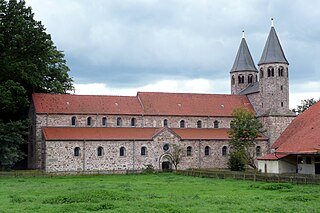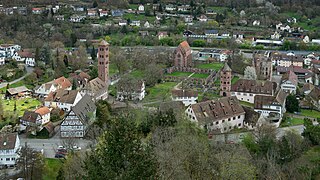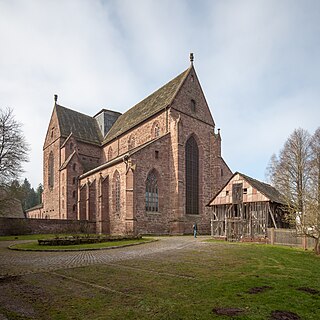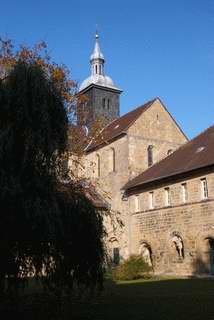
Loccum Abbey (German : Kloster Loccum) is a Lutheran monastery, formerly a Cistercian abbey, in the town of Rehburg-Loccum, near Lake Steinhude, Lower Saxony, Germany.

Loccum Abbey (German : Kloster Loccum) is a Lutheran monastery, formerly a Cistercian abbey, in the town of Rehburg-Loccum, near Lake Steinhude, Lower Saxony, Germany.

A Roman Catholic monastery run by the Cistercians, Loccum Abbey originated as a foundation of Count Wilbrand of Hallermund, and was settled from Volkenroda Abbey under the first abbot, Ekkehard, in 1163. An ancient account describes it as being "in a place of horror and a desert of solitude and a dwelling of thieves and brigands" (Latin : in loco horroris et vastæ solitudinis et prædonum et latronum commorationis); [a] and adds that, after suffering much from want and from the barbarity of their neighbours, the monks in time brought the land into cultivation, and the people to the fear of God. [1] Loccum very quickly grew wealthy and was under the direct protection of the Pope and the Emperor as an Imperial abbey (i.e., territorially independent).
In the 16th century in Protestant Reformation it became Lutheran. By 1700 the abbot of Loccum was permitted to marry and the Loccum Hof was built at Hanover to accommodate his spouse. [2] The monastery retained its property and wealth until the agrarian reforms of the 19th century, when it was included in the territory of the Duchy of Braunschweig-Lüneburg, otherwise Hanover.
Since 1891 the monastery has also operated as a Protestant seminary and academy, a tradition going back to around the start of the 19th century. The title of abbot is retained, anomalously. [1]
The community today generally consists of between four and eight members, most of whom are also in holy orders. In addition the Lutheran Bishop of Hanover and the Director of Studies of the seminary are members ex officio. The abbot and prior are chosen from among the members.
The abbey is known for its extremely well preserved monastic buildings from the late Romanesque period with church, cloister and associated rooms, chapter-house, sacristy, dormitory, refectory, library, [3] lay-brothers' wing, as well as the various service buildings. The buildings as a whole are considered of equal architectural worth with Maulbronn Abbey and Bebenhausen Abbey.[ citation needed ] The monastery's ponds and woods also throw an interesting light on the abbey's medieval economy.[ how? ]
Construction of the abbey church of Saints Mary and George –now St. George's parish church –was completed around 1250. [4]

A religious order is a subgroup within a larger confessional community with a distinctive high-religiosity lifestyle and clear membership. Religious orders often trace their lineage from revered teachers, venerate their founders, and have a document describing their lifestyle called a rule of life. Such orders exist in many of the world's religions.
The United Evangelical Lutheran Church of Germany was founded on July 8, 1948, in Eisenach, Germany. Its total membership is 7.5 million people. All its member churches belong to the Protestant Church in Germany, with which it co-operates closely. In 2018 it has been reduced from an independent legal entity to an administrative unit within the larger Protestant Church in Germany.

Maulbronn Monastery is a former Cistercian abbey and ecclesiastical state in the Holy Roman Empire located at Maulbronn, Baden-Württemberg. The monastery complex, one of the best-preserved in Europe, was named a UNESCO World Heritage Site in 1993.

Bursfelde Abbey is a former Benedictine monastery located in Bursfelde, a hamlet which for administrative purposes is included in the municipality of nearby Hannoversch Münden in Lower Saxony, Germany. Today the abbey church and its estate cover a site of approximately 300 hectares which is administered by the Klosterkammer Hannover, a body that operates under the auspices of the Lower Saxony Ministry for Arts and the Sciences to look after reassigned or disused ecclesiastical buildings and other heritage properties in the region. The legal owner of the Bursfelde Monastery Complex is the Evangelical-Lutheran Church of Hanover.

Hirsau Abbey, formerly known as Hirschau Abbey, was once one of the most important Benedictine abbeys of Germany. It is located in the Hirsau borough of Calw on the northern slopes of the Black Forest mountain range, in the present-day state of Baden-Württemberg. In the 11th and 12th century, the monastery was a centre of the Cluniac Reforms, implemented as "Hirsau Reforms" in the German lands by William of Hirsau. The complex was devastated during the War of the Palatine Succession in 1692 and not rebuilt. The ruins served as a quarry for a period of time.

Reinfeld Abbey was a Cistercian monastery in Reinfeld near Bad Oldesloe in Schleswig-Holstein in northern Germany.

Lehnin Abbey is a former Cistercian monastery in Lehnin in Brandenburg, Germany. Founded in 1180 and secularized during the Protestant Reformation in 1542, it has accommodated the Luise-Henrietten-Stift, a Protestant deaconesses' house since 1911. The foundation of the monastery in the newly established Margraviate of Brandenburg was an important step in the high medieval German Ostsiedlung; today the extended Romanesque and Gothic brickstone buildings, largely restored in the 1870s, are a significant part of Brandenburg's cultural heritage.

Walkenried Abbey was a Cistercian abbey located in the village of Walkenried in Lower Saxony, Germany. Founded in 1127 on the southern rim of the Harz mountain range, the remnants of the monastic complex since 2010 are part of the Upper Harz Water Regale World Heritage Site.

The Evangelical-Lutheran Church of Hanover is a Lutheran church body (Landeskirche) in the northern German state of Lower Saxony and the city of Bremerhaven covering the territory of the former Kingdom of Hanover.

Schöntal Abbey is a former Cistercian abbey in Schöntal in the district of Hohenlohe, Baden-Württemberg, Germany. It is famous as one of the most impressive pieces of Baroque architecture in northern Württemberg and is now used by the Diocese of Rottenburg-Stuttgart as a retreat and training centre.

Wienhausen Abbey or Convent near Celle in Lower Saxony, Germany, is a community of Evangelical Lutheran women, which until the Reformation was a Cistercian Catholic nunnery. The abbey owns significant artworks and artifacts, including a collection of tapestries and the earliest surviving example of a type of eyeglasses.

Munkeby Abbey was a Cistercian monastery near the village of Okkenhaug in the municipality of Levanger in Trøndelag county, Norway. It was located about 5 kilometres (3.1 mi) east of the town of Levanger. The name "Munkeby" in Norwegian means Place of the Monks. It was closed during the Protestant Reformation. Today the former abbey is the sight of medieval ruins which are managed by the Society for the Preservation of Ancient Norwegian Monuments.

Amelungsborn Abbey, also Amelunxborn Abbey, is a Lutheran monastery in Lower Saxony, Germany. It is located near Negenborn and Stadtoldendorf, in the Landkreis of Holzminden in the Weserbergland. It was the second oldest Cistercian foundation in Lower Saxony, Germany, after Walkenried Abbey. It survived the Reformation by becoming Lutheran, and with Loccum Abbey, also previously Cistercian, is one of the only two Lutheran monasteries in Germany with an uninterrupted tradition. The abbey church, St. Mary's, is also the parish church of the abbey's former estate villages Negenborn and Holenberg.

Johannes (Hanns) Ernst Richard Lilje was German Lutheran bishop and one of the pioneers of the ecumenical movement.

Isenhagen Abbey is a convent in Hankensbüttel in the district of Gifhorn in the German state of Lower Saxony. It was a nunnery founded by the Cistercian order but is now a Lutheran women's convent. It is managed by the monastic chamber in Hanover.

Medingen Abbey or Medingen Convent is a former Cistercian nunnery. Today it is a residence for women of the Protestant Lutheran faith near the Lower Saxon town of Bad Bevensen and is supervised by the Monastic Chamber of Hanover. The current director of the abbey (Äbtissin) is the art historian Dr Kristin Püttmann.

Mariental Abbey, in the present-day municipality of Mariental in Lower Saxony, Germany, is a former Cistercian monastery founded in 1138, now used and owned by a Lutheran congregation of the Evangelical Lutheran Church in Brunswick.

Gerhard Wolter Molanus was Lutheran theologian and abbot of Loccum.

Hans Joachim Schliep is a German Lutheran theologian, pastor and author. From 1990 to 1999 he was director of the Amt für Gemeindedienst, and by May 2000 the commissioner for the environment of the Church of Hanover and the Confederation of Protestant Churches in Lower Saxony. From 1999 to 2008 Schliep was the first pastor at the Kronsberg Church Centre and founder of the congregation at the Expo-neighbourhood in Kronsberg, Hanover, Lower Saxony, Germany.